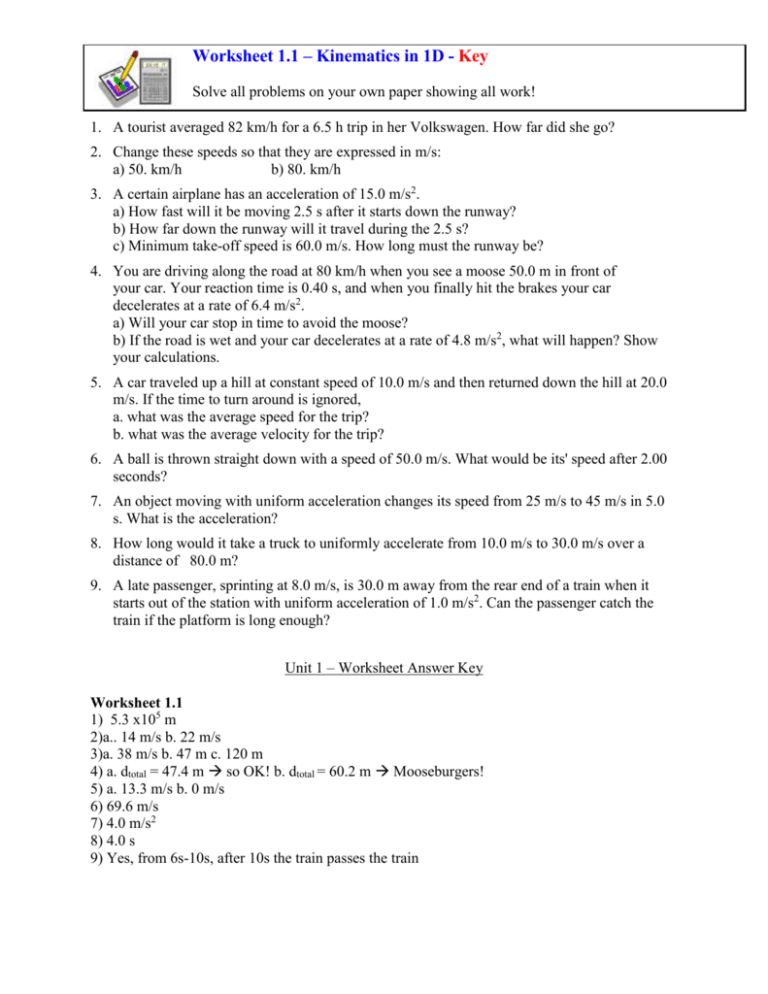42 kinematics worksheet 1 answers
Unit 2 Kinematics Worksheet 1: Position vs. Time and … Unit 2 Kinematics Worksheet 1: Position vs. Time and Velocity vs. Time Graphs Sketch velocity vs. time graphs corresponding to the following descriptions of the motion of an object: 1. The object moves toward the origin at a steady speed for 10s, then stands still for 10s. There are 2 possibilities: a) (in red ) object moves toward origin in Kinematics worksheets - Physicscatalyst Question 1. A bus start at Station A from rest with uniform acceleration 2m/sec 2.Bus moves along a straight line a. Find the distance moved by the bus in 10 sec? b. At what time, it velocity becomes 20m/sec?
HyperPhysics - GSU The side bar contains a link to the extensive Index, which itself is composed of active links. That sidebar also contains links to relevant concept maps. The rationale for such concept maps is to provide a visual survey of conceptually connected material, and it is hoped that they will provide some answers to the question "where do I go from ...

Kinematics worksheet 1 answers
Momentum and Collisions Review - with Answers #2 - Physics Classroom So any change in mass will result in the same change in force; and any change in time will result in the inverse effect upon the force. In this case, halving the mass (from M to 1/2-M) will half the force and halving the time (from t to 1/2-t) will double the force. The combined effect of these two changes will make the new force the same size ... Kinematic Equations: Sample Problems and Solutions - Physics Classroom Kinematic equations relate the variables of motion to one another. Each equation contains four variables. The variables include acceleration (a), time (t), displacement (d), final velocity (vf), and initial velocity (vi). If values of three variables are known, then the others can be calculated using the equations. This page demonstrates the process with 20 sample problems and … Acceleration - Physics Classroom For questions #5-#8: An object is moving in a clockwise direction around a circle at constant speed. Use your understanding of the concepts of velocity and acceleration to answer the next four questions. Use the diagram shown at the right. 5. Which vector below represents the direction of the velocity vector when the object is located at point B on the circle?
Kinematics worksheet 1 answers. Work and Energy Review - with Answers #1 - Physics Classroom Answer: ACDHIKNO. a. TRUE - Work is a form of energy, and in fact it has units of energy.. b. FALSE - Watt is the standard metric unit of power; Joule is the standard metric unit of energy.. c. TRUE - A N•m is equal to a Joule. d. TRUE - A kg•m 2 /s 2 is a mass unit times a speed squared unit, making it a kinetic energy unit and equivalent to a Joule.. e. FALSE - Work is not dependent … Graphs of Motion - Practice – The Physics Hypertextbook The third and fourth methods use the other two equations of motion. Since these rely on our choices for the final velocity, multiple valid answers are possible. Let's say we use the velocity calculated from the slope of a "tangent" with a value of −60 m/s and and the velocity-time relationship, a.k.a. the first equation of motion. Then… Electric Circuits Review - Answers #2 - Physics Classroom The current (I) is the quantity of charge flowing past a point (Q) in a given amount of time (t). That is, I = Q/t. So in this case, the current at point A is (6 C) / (4 s) or 1.5 amperes. Thus the Q/t ratio is 1.5 regardless of the time. So solve the equation . 1.5 C/s = Q / (8 s) for Q to obtain the answer. 1D Kinematics Review - with Answers - Physics Classroom Answer: See answers, explanations and calculations below. a. If the speed and direction of an object is constant, then the acceleration is 0 m/s 2. b. The acceleration is the velocity change per time ratio: a = (Velocity Change)/t = (23.5 m/s - 12.1 m/s) / (7.81 s) = 1.46 m/s 2. c. The acceleration is the velocity change per time ratio:
Acceleration - Physics Classroom For questions #5-#8: An object is moving in a clockwise direction around a circle at constant speed. Use your understanding of the concepts of velocity and acceleration to answer the next four questions. Use the diagram shown at the right. 5. Which vector below represents the direction of the velocity vector when the object is located at point B on the circle? Kinematic Equations: Sample Problems and Solutions - Physics Classroom Kinematic equations relate the variables of motion to one another. Each equation contains four variables. The variables include acceleration (a), time (t), displacement (d), final velocity (vf), and initial velocity (vi). If values of three variables are known, then the others can be calculated using the equations. This page demonstrates the process with 20 sample problems and … Momentum and Collisions Review - with Answers #2 - Physics Classroom So any change in mass will result in the same change in force; and any change in time will result in the inverse effect upon the force. In this case, halving the mass (from M to 1/2-M) will half the force and halving the time (from t to 1/2-t) will double the force. The combined effect of these two changes will make the new force the same size ...

0 Response to "42 kinematics worksheet 1 answers"
Post a Comment